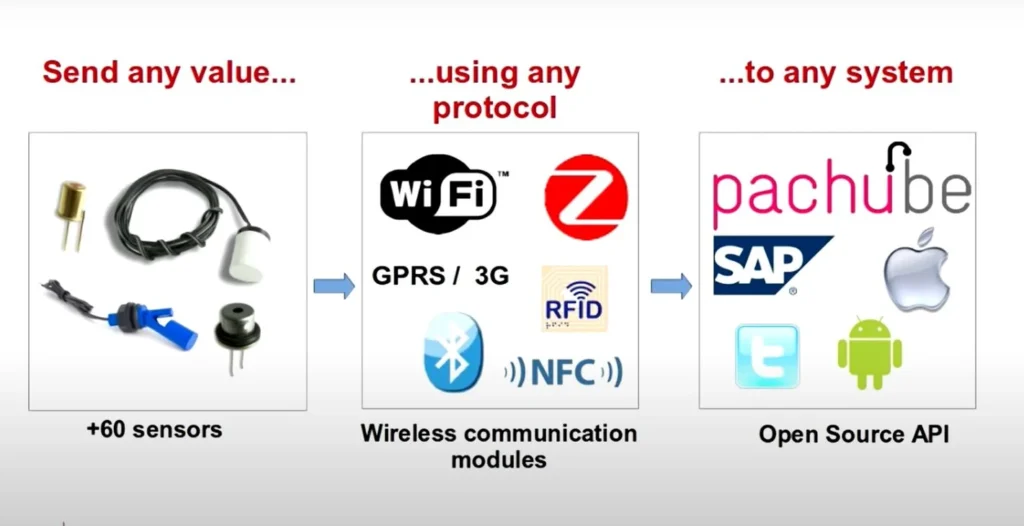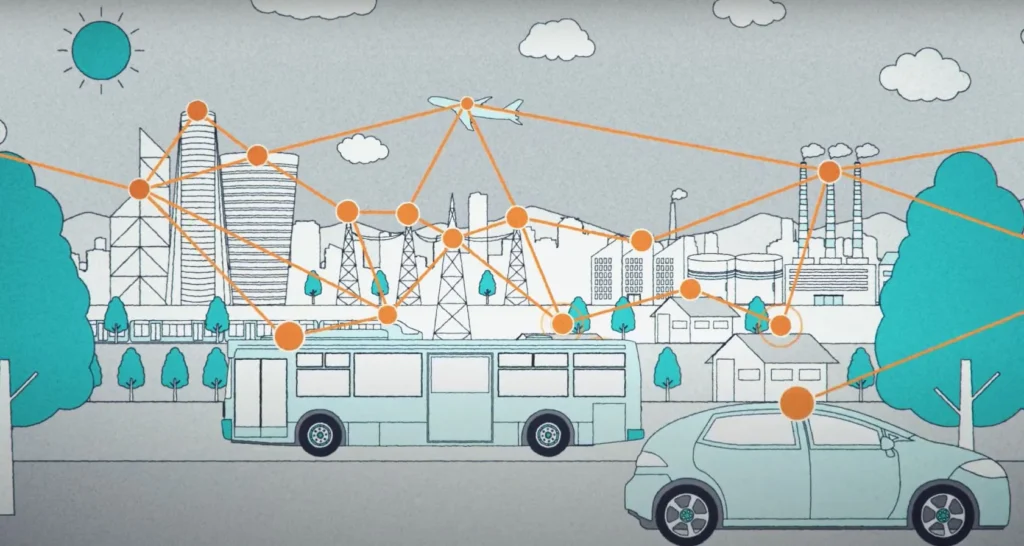Wireless Sensor Networks, or WSN, use a sensor network to identify and react to various environmental and physical conditions like light, pressure, heat, and so forth.

The intelligent use of low-power sensors across a wide range has been made possible by advancements in wireless technology and MEMS (Micro Electro Mechanical System) sensors, resulting in low-cost WSNs for both military and civilian applications.
The types of WSNs, their parts and uses, as well as their benefits and drawbacks, are covered in the section that follows.
You can also read What is a LAN, or local area network
What does the term “network” mean?
Devices that facilitate resource sharing and information exchange are connected by networks. These integrated devices make use of communication protocols, which are collections of guidelines for sending data over wired or wireless networks. Examples of these protocols are TCP/IP, UDP, FTP, HTTP, SMTP, etc.
Networks can be classified as either wired or wireless. The cost, communication range, data security, and data transmission speed of wired and wireless networks vary.
In contrast to wireless networks, which use radio waves to connect devices, wired networks use physical cables to link devices. Numerous wireless technologies are available, including Bluetooth, Wi-Fi, and others.
As the name implies, wireless technology is used for wireless sensor networks (WSN), and radio signals are used for communication.
A Wireless Sensor Network (WSN): What is it?
In order to record and monitor physical environmental parameters and organize the resulting data in a central location, a wireless sensor network, or WSN, is a collection of specialized sensors placed in various locations within specific structures.
These physical characteristics include, among other things, humidity, wind, pressure, and temperature.
An enterprise WSN network – It uses wireless communication between nodes and base stations that are dispersed throughout the area. There are four methods for implementing the WSN structure: point-to-point, star, tree, and mesh types.
Depending on the physical environment, a WSN arrangement can be divided into five categories: multimedia, mobile, terrestrial, underwater, and subterranean WSNs.
In order to achieve effective outcomes, new sensor designs connect the physical and digital domains through technological advancements.
WSN is made up of sensor-equipped nodes that send data to a base station for reporting and analysis after detecting changes in the environment and physically.
Sophisticated tracking or monitoring systems can have better coverage and security when wireless sensor networks are integrated with GPS or RFID.
WSNs seek to gather environmental data in order to safeguard the environment and enhance productivity, safety, and accident rates.
WSN components
Let’s examine the list of elements that comprise a WSN. The two main components of WSN are network architecture and sensor node architecture.
Node for sensors
The following elements make up the sensor node:
- Power supply: To provide energy to each and every network component.
- Sensor unit: The sensor and the analog-to-digital converter, or ADC, make up this unit. Analog data is gathered by the sensor and converted to digital format by the ADC. Sensor nodes process communication and storage components in addition to their sensor function. Physical data and information relays are gathered, examined, and combined with data from additional sensors by the sensor node.
- Process Unit: Made up of a microprocessor and memory. It manipulates and processes data intelligently.
- Communication system: Data transmission and reception via radio.
- Base station: With a high processing and computing capacity, it is an exceptional node.
- Cluster head: In a wireless sensor network (WSN), this high-bandwidth sensor node is utilized for data fusion and aggregation tasks. There are multiple cluster heads in the cluster, depending on the apps and system requirements.
A Wireless Sensor Network uses wireless communication to monitor the physical environment and a base station (BS) while connecting to other sensor nodes spread across large areas. Data is gathered by the sensor nodes and transmitted to the base station. Base stations process the data and update their online user guides with the latest information.
Architecture of networks
One type of network architecture is known as single-hop networking, in which every sensor node is linked to the base station. Long-distance data transmission uses more energy than data gathering and processing combined. Consequently, rather than utilizing a single link to connect the sensor node to the base station in these situations, a multi-hop network architecture employing intermediate nodes is frequently employed.

These structures can be implemented in two different ways: hierarchical network architecture and flat network architecture.
All sensor nodes in the flat architecture are under the base station’s control, and they communicate with one another via peer nodes via a multi-hop path.
Data is forwarded to the base station by cluster heads in the hierarchical network architecture after they have received information from a collection of sensor nodes.
Additional WSN components
- Relay nodes – A middle node is used to communicate with the nearby node. It has no process sensor or control devices and improves network reliability.
- Performer node: A high-end node is employed to execute and generate a decision based on the demands of the application. These nodes are usually resource-rich devices with long battery lives, high transmission power, and high quality process radio capabilities.
- GateWay: This is an interface that connects external networks and sensor networks. The GateWay node is more powerful than the sensor node and cluster head in terms of program and data memory, transceiver range, and potential for expansion through external memory.
Wireless sensor network types (WSN)
Five distinct kinds of WSN exist:
- Below the water: Submerged Sensor nodes and submerged vehicles are used by the wireless sensor network to gather data. There is a lot of latency. Sensor interference issues are present, and the quantity of non-rechargeable batteries is restricted.
- Underground: This kind of monitor operates entirely underground, using sink nodes positioned above ground to send data to the base station. This is because of the underground conditions. The costs are more than terrestrial networks because of the costly equipment and maintenance.
- Terrestrial: This kind of network is used to track various locations’ environmental conditions on land. In terrestrial WSNs, thousands of wireless sensor nodes are either deployed beforehand or on-demand. Plan the structure for effective communication with base stations.
- Multimedia: WSNs are capable of tracking and keeping an eye on events involving audio, video, and image. Their sensor nodes are reasonably priced, equipped with wirelessly connected cameras and microphones that can retrieve, compress, and adjust relevant data.
- Mobile: Sensor nodes that are part of mobile WSNs are able to move around and communicate while carrying out sensor tasks. Mobile wireless sensor networks are more flexible, cover more ground, have better channel capacity, and use less energy than stationary sensor networks.
The application and the ground requirements determine how the WSN type is used.
Various WSN structures
There are four different kinds of network structures, but depending on which one is used, data routing and process modifications can have an impact on latency, capacity, and robustness. As a result, before the WSN structure is deployed, the requirements and application type should be evaluated.

In order to send data to the cloud for additional analysis, the nodes can also be wired to the Internet.
- Point-to-point: This type of network allows sensors to speak with one another directly without the need for a central hub. This structure guarantees secure communication and is widely used.
- Star structure: The star network is simple to set up and low power, using a base station as the central node for communication with all sensors. This structure’s reliance on a single base station for communication is one of its drawbacks.
- A hybrid or tree structure that blends star and point-to-point organization. The sensors in this structure are grouped like a tree, and branches connect the sensors to transmit data. In comparison to other structures, it uses less energy.
- Network structure: This structure allows for multi-hop communication without the need for a central base station by allowing data transmission between sensors within their respective transmission areas. Sensors are able to utilize Outside of their radio coverage area, intermediate sensors send data to other sensors. As a result, its redundancy and scalability are well known. Although it needs more power, it is thought to be the most dependable because there isn’t a single point of failure.
Applications of WSN
WSNs are utilized in many fields where it is necessary to measure, track, or monitor data. They cover a large area and are used in a variety of applications to measure sound, temperature, and other parameters.
- They are frequently used in the military to identify enemy invasions because they are employed to monitor regions by using sensors to detect intrusion attempts.
- They are widely used in civilian applications, including agriculture, mining, healthcare, surveillance, and other monitoring settings.
- Micro-radars and magnetometers can be used for localization, and wireless sensor nodes can use magnetometers to detect parked cars.
- Wireless sensor networks (WSNs) are widely used in environmental/earth monitoring and sensing applications, including habitat monitoring, water quality monitoring, landslide detection, and natural disaster prevention. Additionally well-known in the industry are monitoring solutions for structural health, waste management, machine health, and other areas.
Benefits and drawbacks from wireless sensor networks

We examine the benefits and drawbacks of WSN in this section:
Benefits
- WSNs are favored over wired network monitoring systems because of their affordability, ease of deployment, dependability, and convenience.
- WSN does away with the requirement for wires or cables.
- The Numerous factors contribute to the efficiency, including low human involvement, fault tolerance, connectivity, coverage area, detection accuracy, functionality in difficult conditions, and dynamic sensor scheduling.
- Makes it possible to monitor every node in the WSN centrally.
- Easily adjustable to different physical divides.
- Routing protocols that enable multi-hop communication to create self-organizing ad hoc networks in environments with limited power and bandwidth.
- To build a dependable network for users, security algorithms based on wireless technology are employed.
- Enables scalability by making it simple to integrate additional nodes or devices.
Negative aspects
- WSNs encounter issues with constrained bandwidth, excessive energy usage, costly node expenses, deployment strategies, and limitations in hardware and software design.
- Hacker attacks can target wireless sensor networks.
- WSNs are not appropriate for high-speed communication; instead, they are meant for low-speed applications.
- The construction of WSN networks is costly.
- If the central node fails in a WSN with a star topology, the network as a whole may go down.
In brief
Numerous applications involving tracking and monitoring depend on wireless sensor networks, or WSNs. From simple sensor monitoring to sophisticated sensing, processing, and analysis, the WSN has developed over time. WSN technology has evolved dramatically in order to obtain important data and produce the intended outcomes.